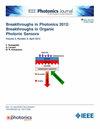Rigorous Design Optimization of a Fiber-Enabled Polarimetric Waveguide Interferometer for Biosensing
IF 2.1
4区 工程技术
Q3 ENGINEERING, ELECTRICAL & ELECTRONIC
引用次数: 0
Abstract
Integrated photonic sensors have gained significant attention for biosensing applications. An especially potent design is the polarimetric waveguide interferometer, which utilizes polarization diversity for effective self-referencing. However, its implementations are held back by the need for bulky free-space optics or unreliable waveguide junctions for polarization handling. To overcome these limitations, we propose a novel concept for a compact photonic system that employs edge couplers to excite both polarizations from an optical fiber and an in-line polarizer to obtain the phase information in the fiber-based readout. Additionally, we improve the waveguide design methodology to minimize the limit of detection through balancing sensitivity with optical loss. To this end, we create a unified perturbative approach based on atomic force microscopy and ellipsometry data to model sensitivity, surface-roughness-induced scattering, absorption, and radiation. We then incorporate the coupling efficiency into a figure of merit for the combined system. Thus, we optimize the geometry of a strip waveguide on a CMOS-foundry-sourced silicon nitride platform for biosensing. Through exhaustive screening of the design space, we discover that polarization diversity simultaneously leverages high sensitivity and low overlap with sidewall roughness. Further, we present designs that eliminate the phase signal from two major noise sources: thermal and bulk refractive index fluctuations. Finally, we provide design recommendations and achieve a 5.2-fold improvement over a comparable bimodal waveguide interferometer. Thus, our aim is to design a robust, compact, sensitive, and cost-effective polarimetric waveguide interferometer through an efficient concept and an optimized design.用于生物传感的光纤偏振波导干涉仪的严格设计优化
集成光子传感器在生物传感应用中备受关注。偏振波导干涉仪是一种特别有效的设计,它利用偏振分集实现有效的自参照。然而,由于需要使用笨重的自由空间光学器件或不可靠的波导连接来处理偏振,这种设计的实现受到了阻碍。为了克服这些局限性,我们提出了一种紧凑型光子系统的新概念,即利用边缘耦合器从光纤中激发两种偏振,并利用在线偏振器获取光纤读出器中的相位信息。此外,我们还改进了波导设计方法,通过平衡灵敏度和光损耗,最大限度地降低探测极限。为此,我们以原子力显微镜和椭偏仪数据为基础,创建了一种统一的扰动方法,对灵敏度、表面通透性引起的散射、吸收和辐射进行建模。然后,我们将耦合效率纳入到组合系统的优点系数中。因此,我们优化了用于生物传感的 CMOS 铸造氮化硅平台上带状波导的几何形状。通过对设计空间的详尽筛选,我们发现偏振分集可同时利用高灵敏度和侧壁粗糙度的低重叠性。此外,我们还介绍了可消除两大噪声源(热和体折射率波动)产生的相位信号的设计。最后,我们提供了设计建议,并实现了比同类双模波导干涉仪高 5.2 倍的改进。因此,我们的目标是通过高效的概念和优化的设计,设计出坚固耐用、结构紧凑、灵敏度高、成本效益高的偏振波导干涉仪。
本文章由计算机程序翻译,如有差异,请以英文原文为准。
求助全文
约1分钟内获得全文
求助全文
来源期刊

IEEE Photonics Journal
ENGINEERING, ELECTRICAL & ELECTRONIC-OPTICS
CiteScore
4.50
自引率
8.30%
发文量
489
审稿时长
1.4 months
期刊介绍:
Breakthroughs in the generation of light and in its control and utilization have given rise to the field of Photonics, a rapidly expanding area of science and technology with major technological and economic impact. Photonics integrates quantum electronics and optics to accelerate progress in the generation of novel photon sources and in their utilization in emerging applications at the micro and nano scales spanning from the far-infrared/THz to the x-ray region of the electromagnetic spectrum. IEEE Photonics Journal is an online-only journal dedicated to the rapid disclosure of top-quality peer-reviewed research at the forefront of all areas of photonics. Contributions addressing issues ranging from fundamental understanding to emerging technologies and applications are within the scope of the Journal. The Journal includes topics in: Photon sources from far infrared to X-rays, Photonics materials and engineered photonic structures, Integrated optics and optoelectronic, Ultrafast, attosecond, high field and short wavelength photonics, Biophotonics, including DNA photonics, Nanophotonics, Magnetophotonics, Fundamentals of light propagation and interaction; nonlinear effects, Optical data storage, Fiber optics and optical communications devices, systems, and technologies, Micro Opto Electro Mechanical Systems (MOEMS), Microwave photonics, Optical Sensors.
 求助内容:
求助内容: 应助结果提醒方式:
应助结果提醒方式:


